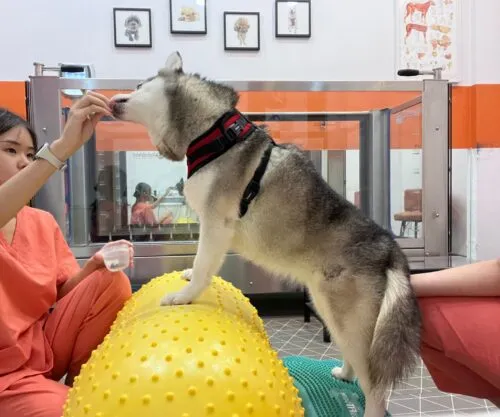
As pet owners, we want nothing but the best for our furry friends. However, there may come a time when our beloved pets face mobility issues due to various reasons such as age, injury, or medical conditions. In such cases, pet rehabilitation exercises can play a crucial role in improving their mobility and overall quality of life. In this article, we will explore common pet rehabilitation exercises that can help enhance your pet’s mobility. By incorporating these exercises into their daily routine, you can assist your furry companion in regaining strength, flexibility, and vitality.
Table of Contents
ToggleOne of the primary goals of pet rehabilitation is to maintain and improve joint flexibility. Passive Range of Motion (PROM) exercises are gentle movements performed by the pet owner to stimulate joint mobility. These exercises involve slowly and carefully moving the pet’s limbs through their full range of motion. It is crucial to perform PROM exercises without causing any discomfort or pain to the pet. Regular practice of PROM exercises can help prevent stiffness, muscle atrophy, and joint contractures in pets.
Weight-shifting exercises are beneficial for pets who struggle with balance and weight-bearing. These exercises involve encouraging the pet to shift their weight from one limb to another while maintaining stability. For example, you can use treats or toys to entice your pet to lean towards one side, then gradually shift their weight to the other side. Weight-shifting exercises help strengthen the supporting muscles, improve coordination, and enhance overall stability.
Hydrotherapy is a popular rehabilitation technique that utilizes water to aid in the recovery of pets with mobility issues. This exercise is particularly beneficial for pets with joint problems, muscle weakness, or those recovering from surgery. Under the guidance of a professional therapist, pets are encouraged to swim or walk on an underwater treadmill. The buoyancy of water reduces the impact on joints and provides resistance for muscle strengthening. Hydrotherapy helps improve cardiovascular fitness, range of motion, and overall mobility in pets.
Balance and proprioception exercises focus on improving a pet’s coordination, spatial awareness, and body positioning. These exercises challenge the pet’s stability and help them regain their balance. Some common balance and proprioception exercises include having the pet stand on unstable surfaces like balance discs or foam pads, or performing controlled movements on a wobble board. Regular practice of these exercises enhances the pet’s proprioceptive abilities, reduces the risk of falls, and promotes better motor control.
Strength training exercises are essential for building muscle mass and improving overall strength and endurance in pets. These exercises involve controlled movements that target specific muscle groups. For example, you can encourage your pet to perform sit-to-stand exercises or gentle stair climbing. Strength training exercises should be tailored to your pet’s abilities and gradually increased in intensity. Regular strength training improves muscle tone, enhances joint stability, and supports better mobility.
Stretching exercises play a vital role in maintaining flexibility and preventing muscle tightness in pets. These exercises involve the gentle elongation of muscles and soft tissues. For example, you can perform gentle neck stretches or hind limb stretches for your pet. It is crucial to approach stretching exercises with caution and avoid forcing the stretch beyond the pet’s comfort level. Regular stretching exercises improve the range of motion, relieve muscle tension, and promote better flexibility.
A1: The frequency of pet rehabilitation exercises depends on various factors, including your pet’s condition and the recommendations of your veterinarian or rehabilitation specialist. In general, it is advisable to perform exercises at least 3-4 times a week. However, it is essential to consult with a professional to develop a tailored exercise plan for your pet.
A2: While some simple exercises can be performed at home, it is recommended to seek professional guidance, especially if your pet has specific mobility issues or is recovering from surgery. Rehabilitation specialists can provide expert advice, design a personalized exercise program, and ensure the exercises are performed correctly and safely.
A3: The suitability of these exercises may vary depending on your pet’s specific condition and overall health. It is essential to consult with your veterinarian or a certified rehabilitation specialist to determine the most appropriate exercises for your pet. They can assess your pet’s individual needs and create a customized plan accordingly.
A4: The rate of improvement in your pet’s mobility can vary depending on several factors, including the severity of the condition, the pet’s overall health, and the consistency of the rehabilitation exercises. Some pets may show improvement within a few weeks, while others may take several months to experience noticeable changes. Patience and consistency are key when it comes to pet rehabilitation.
A5: While performing pet rehabilitation exercises, it is essential to monitor your pet’s behaviour and responses closely. If you notice any signs of pain, discomfort, excessive fatigue, or worsening of symptoms, it is crucial to stop the exercises and consult with your veterinarian or rehabilitation specialist. They can assess the situation and make necessary adjustments to the exercise program.
A6: Pet rehabilitation exercises are not intended to replace medical treatments or interventions. They are a complementary approach that can support the recovery process and enhance your pet’s overall well-being. It is crucial to follow your veterinarian’s recommendations and integrate pet rehabilitation exercises as part of a comprehensive treatment plan.
Pet rehabilitation exercises are valuable tools for improving mobility and overall quality of life for pets facing mobility issues. By incorporating a variety of exercises, including passive range of motion, weight-shifting, hydrotherapy, balance and proprioception, strength training, and stretching, you can assist your furry companion in regaining their mobility and vitality. Remember to consult with a veterinarian or certified rehabilitation specialist to develop a customized exercise plan that suits your pet’s individual needs. With dedication, patience, and proper guidance, you can help your pet enjoy a happier, healthier, and more active life.